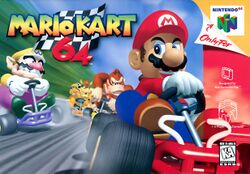No edit summary |
m (Update guide main page) |
||
| (32 intermediate revisions by 14 users not shown) | |||
| Line 1: | Line 1: | ||
{{ | {{Header Nav|game=Mario Kart 64}} | ||
{{ | {{Game | ||
|completion=2 | |||
|image=Mario Kart 64.jpg | |||
|title=Mario Kart 64 | |title=Mario Kart 64 | ||
|developer=[[Nintendo EAD]] | |||
|developer=[[Nintendo]] | |||
|publisher=[[Nintendo]] | |publisher=[[Nintendo]] | ||
| | |year=1996 | ||
|systems= | |systems={{syslist|n64|ique|wii|wiiu|switch}} | ||
| | |ratings={{CERO|A}}{{ESRB|KA}}{{PEGI|3}}{{OFLC|G}} | ||
|genre=[[Racing]] | |||
|players=1-4 | |players=1-4 | ||
| | |modes=[[Single player]], [[Multiplayer]] | ||
|preceded by=[[Super Mario Kart]] | |preceded by=[[Super Mario Kart]] | ||
|followed by=[[Mario Kart Super Circuit]] | |followed by=[[Mario Kart Super Circuit]] | ||
|series=Mario Kart | |||
}} | }} | ||
'''Mario Kart 64''' (マリオカート64, ''Mario Kāto roku-juu-yon'') is a [[Racing]] video game for the [[Nintendo 64]] game system; it can utilize up to four human controlled players in some modes of play. It is the sequel to ''[[Super Mario Kart]]'' for the [[SNES]]. While being developed, it was known as Super Mario Kart R. Players take control of characters from the ''Super Mario Bros.'' video game series by racing around a variety of tracks while using several weapons; including items that make the racers' speed increase, shoot turtle-shell projectiles, and drop or throw slippery banana peels. The game was developed and published by [[Nintendo]] and released on December 14, [[1996]] in Japan, on February 10, [[1997]] in North America, on June 24, [[1997]] in Europe, and on July 10, [[1997]] in Australia. In January 2007, the game was made available on the [[Wii Virtual Console]] and the [[Wii U Virtual Console]] in January 2016. Music for the game was composed by Koji Kondo, who has also composed scores for many Nintendo games, and Kenta Nagata. | |||
<gallery> | |||
File:Mario Kart 64 JP box.jpg|Japanese box | |||
</gallery> | |||
{{ToC}} | |||
{{ | |||
==External links== | |||
* [http://www.mariokart64.com ''Mario Kart 64'' Player's Page.] | |||
* [http://speeddemosarchive.com/MarioKart64.html ''Mario Kart 64'' Time Trials Videos at SDA.] | |||
{{Mario Kart}} | |||
[[Category:Nintendo Entertainment Analysis and Development]] | |||
[[Category:Nintendo]] | |||
[[Category:Racing]] | [[Category:Racing]] | ||
[[Category:Single player]] | [[Category:Single player]] | ||
[[Category:Multiplayer]] | [[Category:Multiplayer]] | ||
Latest revision as of 16:39, 30 March 2023

| Mario Kart 64 | |
|---|---|
| Developer(s) | Nintendo EAD |
| Publisher(s) | Nintendo |
| Year released | 1996 |
| System(s) | Nintendo 64, iQue Player, Wii, Wii U, Nintendo Switch |
| Preceded by | Super Mario Kart |
| Followed by | Mario Kart Super Circuit |
| Series | Mario Kart |
| Genre(s) | Racing |
|---|---|
| Players | 1-4 |
| Modes | Single player, Multiplayer |
| Rating(s) |
Mario Kart 64 (マリオカート64, Mario Kāto roku-juu-yon) is a Racing video game for the Nintendo 64 game system; it can utilize up to four human controlled players in some modes of play. It is the sequel to Super Mario Kart for the SNES. While being developed, it was known as Super Mario Kart R. Players take control of characters from the Super Mario Bros. video game series by racing around a variety of tracks while using several weapons; including items that make the racers' speed increase, shoot turtle-shell projectiles, and drop or throw slippery banana peels. The game was developed and published by Nintendo and released on December 14, 1996 in Japan, on February 10, 1997 in North America, on June 24, 1997 in Europe, and on July 10, 1997 in Australia. In January 2007, the game was made available on the Wii Virtual Console and the Wii U Virtual Console in January 2016. Music for the game was composed by Koji Kondo, who has also composed scores for many Nintendo games, and Kenta Nagata.
-
Japanese box
